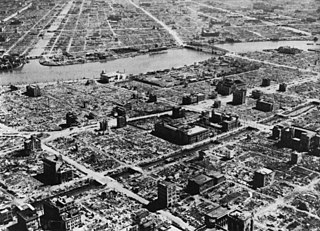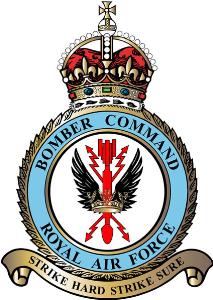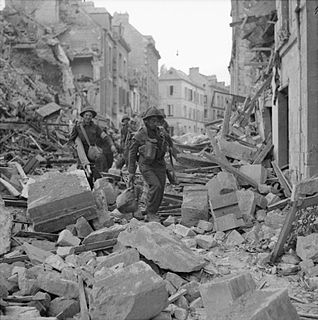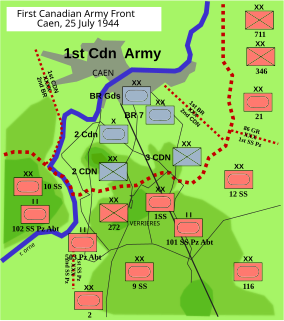
Strategic bombing is a military strategy used in total war with the goal of defeating the enemy by destroying its morale, its economic ability to produce and transport materiel to the theatres of military operations, or both. It is a systematically organized and executed attack from the air which can utilize strategic bombers, long- or medium-range missiles, or nuclear-armed fighter-bomber aircraft to attack targets deemed vital to the enemy's war-making capability.

Michael Wittmann was a German Waffen-SS tank commander during the Second World War. He is known for his ambush of elements of the British 7th Armoured Division during the Battle of Villers-Bocage on 13 June 1944. While in command of a Tiger I tank, Wittmann destroyed up to fourteen tanks and fifteen personnel carriers, along with two anti-tank guns, within the space of fifteen minutes. The news was picked up and disseminated by the Nazi propaganda machine and added to Wittmann's reputation in Germany.

The military history of the United Kingdom in World War II covers the Second World War against the Axis powers, starting on 3 September 1939 with the declaration of war by the United Kingdom and France, followed by the UK's Dominions and Crown colonies, on Nazi Germany in response to the invasion of Poland by Germany. There was little, however, the Anglo-French alliance could do or did do to help Poland. The Phoney War culminated in April 1940 with the German invasion of Denmark and Norway. Winston Churchill became prime minister and head of a coalition government in May 1940. The defeat of other European countries followed – Belgium, the Netherlands, Luxembourg and France – alongside the British Expeditionary Force which led to the Dunkirk evacuation. Britain and its Empire continued the fight alone against Germany. Churchill engaged industry, scientists and engineers to advise and support the government and the military in the prosecution of the war effort. Germany's planned invasion of the UK was averted by its failure to establish air superiority in the Battle of Britain, and by its marked inferiority in naval power. Subsequently, urban areas in Britain suffered heavy bombing during the Blitz in late 1940 and early 1941. The Royal Navy sought to blockade Germany and protect merchant ships in the Battle of the Atlantic. The Army counter-attacked in the Mediterranean and Middle East, including the North-African and East-African campaigns, and in the Balkans.

RAF Bomber Command controlled the Royal Air Force's bomber forces from 1936 to 1968. Along with the United States Army Air Forces, it played the central role in the strategic bombing of Germany in World War II. From 1942 onward, the British bombing campaign against Germany became less restrictive and increasingly targeted industrial sites and the civilian manpower base essential for German war production. In total 364,514 operational sorties were flown, 1,030,500 tons of bombs were dropped and 8,325 aircraft lost in action. Bomber Command crews also suffered a high casualty rate: 55,573 were killed out of a total of 125,000 aircrew, a 44.4% death rate. A further 8,403 men were wounded in action, and 9,838 became prisoners of war.
The Allied Expeditionary Air Force (AEAF), also known as the Allied Armies’ Expeditionary Air Force (AAEAF), was the expeditionary warfare component of the Supreme Headquarters Allied Expeditionary Force (SHAEF) which controlled the tactical air power of the Allied forces during Operation Overlord during World War II in 1944.

Strategic bombing during World War II was the sustained aerial attack on railways, harbours, cities, workers' and civilian housing, and industrial districts in enemy territory during World War II. Strategic bombing is a military strategy which is distinct from both close air support of ground forces and tactical air power.

The Royal Air Force Regiment is part of the Royal Air Force and functions as a specialist corps founded by Royal Warrant in 1942. The Corps carries out soldiering tasks relating to the delivery of air power. Examples of such tasks are Non Combatant Evacuation Operations (NEO), recovery of downed aircrew, and in-depth defence of airfields by way of aggressively patrolling a large area of operations outside airfields in hostile environments. In addition the RAF Regiment provides Joint Terminal Attack Controllers (JTACs) to the British Army and Royal Marines, and provides flight size commitment to the Special Forces Support Group.
The Transportation Plan was a plan for strategic bombing during World War II against bridges, rail centres, including marshalling yards and repair shops in France with the goal of limiting the German military response to the invasion of France in June 1944.

Operation Charnwood was an Anglo-Canadian offensive that took place from 8 to 9 July 1944, during the Battle for Caen, part of the larger Operation Overlord in the Second World War. The operation was intended to capture the German-occupied city of Caen, which was an important objective for the Allies during the opening stages of Overlord. It was also hoped that the attack would forestall the transfer of German armoured units from the Anglo-Canadian sector to the American sector to the west, where an offensive was being prepared. The British and Canadians advanced on a broad front and by the evening of the second day had taken Caen up to the Orne and Odon rivers.

The Battle for Caen is the name given to fighting between the British Second Army and the German Panzergruppe West in the Second World War for control of the city of Caen and vicinity, during the larger Battle of Normandy. The battles followed Operation Neptune, the Allied landings on the French coast on 6 June 1944 (D-Day). Caen is about 9 mi (14 km) inland from the Calvados coast astride the Orne River and Caen Canal, at the junction of several roads and railways. The communication links made it an important operational objective for both sides. Caen and the area to the south is flatter and more open than the bocage country in western Normandy; Allied air force commanders wanted the area captured quickly to base more aircraft in France.

Operation Spring was an offensive operation of the Second World War conducted by II Canadian Corps during the Normandy campaign in 1944. The plan was intended to create pressure on the German forces operating on the British and Canadian front simultaneous with Operation Cobra, an American offensive. Operation Spring was intended to capture Verrières Ridge and the villages on the south slope of the ridge. The German defence of the ridge contained the offensive on the first day and inflicted many casualties on the Canadians.

Operation Overlord was the codename for the Battle of Normandy, the Allied operation that launched the successful invasion of German-occupied Western Europe during World War II. The operation was launched on 6 June 1944 with the Normandy Landings (D-Day). A 1,200-plane airborne assault preceded an amphibious assault involving more than 5,000 vessels. Nearly 160,000 troops crossed the English Channel on 6 June, and more than two million Allied troops were in France by the end of August.

The RAF raid on La Caine (1944) was an attack in Normandy by the Second Tactical Air Force of the Royal Air Force (RAF) on 10 June 1944. The attack was made on the château at La Caine, about 12 mi (19 km) to the south-west of the city of Caen, north of Thury-Harcourt. The château had recently been occupied by Panzergruppe West, the command organisation for the German Panzer divisions in France and Belgium.

Operation Astonia was the codename for an Allied attack on the German-held Channel port of Le Havre in France, during the Second World War. The city had been declared a Festung (fortress) by Hitler, to be held to the last man. Fought from 10 to 12 September 1944, the Allied objective was to secure the harbour facilities intact, to deliver supplies to the Allied armies in Continental Europe. The Allies refused to let the civilian population be evacuated, despite offers of free passage by the fortress commander.

Air warfare was a major component in all theaters of World War II, and, together with anti-aircraft warfare, consumed a large fraction of the industrial output of the major powers. Germany and Japan depended on air forces that were closely integrated with land and naval forces; the Axis powers downplayed the advantage of fleets of strategic bombers, and were late in appreciating the need to defend against Allied strategic bombing. By contrast, Britain and the United States took an approach that greatly emphasised strategic bombing, and tactical control of the battlefield by air, as well as adequate air defences. Both Britain and the U.S. built a substantially larger strategic forces of large, long-range bombers. Simultaneously, they built tactical air forces that could win air superiority over the battlefields, thereby giving vital assistance to ground troops. The U.S. and Royal Navy also built a powerful naval-air component based on aircraft carriers, as did the Japanese; these played the central role in the war at sea.

Clearing the Channel Coast was a World War II task undertaken by the First Canadian Army in August 1944, following the Allied Operation Overlord and the victory, break-out and pursuit from Normandy.
RAF Coastal Area was a formation within the Royal Air Force (RAF). Founded in 1919, it was to act as the RAF's premier maritime arm. It was replaced by RAF Coastal Command on 14 July 1936.

No. 130 Squadron of the Royal Air Force was a Second World War and Cold war fighter squadron, and later a strategic missile squadron.
Air Commodore Peter W Gray FRAeS is a retired senior Royal Air Force commander and an air power studies academic.
The British Liberation Army (BLA) was the official name given to the British Army forces which fought on the Western Front of World War II between the Invasion of Normandy and the end of the war. Almost all BLA units were assigned to the 21st Army Group, which also included forces from other countries.














